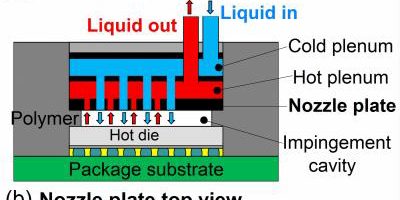Imec demonstrates cost-effective cooling for 3D chips and systems
Research institute, imec, has demonstrated low-cost, impingement-based chip cooling at the package level.
Conventional solutions realise cooling through combining heat exchangers that are bonded to heat spreaders and which are then attached to the rear of the chip and interconnected with thermal interface materials (TIM) that create a fixed thermal resistance. Direct cooling on the rear of the chip would be more efficient, but current direct cooling microchannel options create a temperature gradient across the chip surface, explains imec.
Ideally, an impingement-based cooler with distributed coolant outlets puts the cooling liquid in direct contact with the chip and sprays the liquid perpendicular to the chip surface. This ensures that all the liquid on the chip surface has the same temperature and reduces the contact time between coolant and chip. At present, impingement coolers are silicon-based and thus expensive. Often, adds imec, the nozzle diameters and use processes are not compatible with the chip packaging process flow.
Imec’s impingement chip cooler uses polymers instead of silicon and has nozzles of only 300 micron, made by high-resolution stereolithography 3D printing. It is effectively a 3D printed ‘showerhead’, says Herman Oprins, senior engineer at imec. The printing method allows the nozzle pattern design to be customised to match the heat map and the fabrication of complex internal structures. It allows the whole structure to be printed in one part, which reduces production cost and time.
“3D prototyping has improved in resolution, making it available for realising microfluidic systems such as our chip cooler,” says Oprins. “3D printing enables an application-specific design, instead of using a standard design.”
The cooler achieves a high cooling efficiency, with a chip temperature increase of less than 15 degree C per 100W/cm2 for a coolant flow rate of one litre per minute. Pressure drop can be as low as 0.3 bar, reports imec. The cooler outperforms benchmark conventional cooling in which the thermal interface materials alone already create a 20 to 50 degree C temperature increase. It is also smaller, matching the footprint of the chip package for chip package reduction while meeting the increasing cooling demands of high-performance 3D chips and systems.




